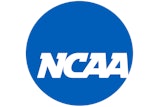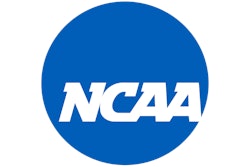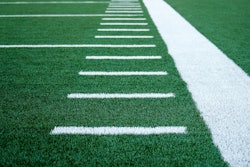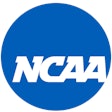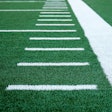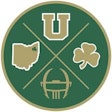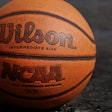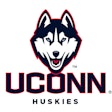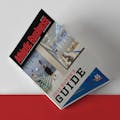Despite some limitations inherent to the design of ballparks, sports facility architects view minor league venues as opportunities to build something unique and personal.
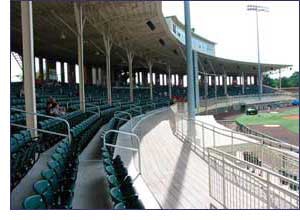 Photo of Gill Stadium in Manchester, N.H.
Photo of Gill Stadium in Manchester, N.H.
Another advantage from a design standpoint is the size and stature of the typical major league venue. With its towering grandstands and banks of lights, not to mention the size of the throng itself, a major league park announces its presence from a great distance, adding to fans' gathering excitement as they approach the entry gates.
Such a situation is less typical in the minors. For every park built in the past decade that can boast New York harbor, the Statue of Liberty and lower Manhattan as its backdrop (Richmond County Bank Ballpark, home of the Staten Island Yankees), there are perhaps 10 others located in nondescript small cities or suburbs, or even along rural highways connecting two small urban centers. These parks, some seating as few as 4,000 spectators, are of a scale that often precludes grand architectural flourishes.
Increasingly, however, sports facility architects are viewing these smaller parks as opportunities to loosen the nostalgic, brick-and-steel grip in which the industry has been held since the runaway success of Baltimore's Oriole Park at Camden Yards, which opened in 1992. In addition, the surge in popularity of minor league baseball since the late 1980s has communities looking to get in on the action and team owners looking to make the kind of aesthetic statement common in the majors.
Flights of fancy are not the norm in the design of competitive sports venues. Unlike, say, a recreation center, a stadium has very specific design requirements. In the case of a ballpark, the diamond will always feature 90-foot basepaths and the outfield dimensions will be close to that of every other ballpark. Structural elements such as the seating bowl will vary little, scoreboards will have an optimum location, and light fixtures must illuminate the same swath of green at the same level as any other comparable park.
And in the case of a minor league ballpark, the smaller budget can even further limit what an architect can do to differentiate the park from others of similar scale. For example, says Mike Westerheid, project manager at Kansas City, Mo.-based HNTB Sports Architecture, the seating bowl is by far the biggest cost involved in building a ballpark, but it's a cost that can be mitigated by handling its construction in a particular way.
"Generally speaking, we have found that excavating a hole and depressing the field, and putting the seating bowl on a sloped grade around that hole, is cheaper than putting the field on grade and building a supporting structure that holds the seats," Westerheid says. "Water-table and other soils issues can get in the way, but if it's at all possible we'll depress it at least to some extent, because of the cost savings."
Another limiting factor is the tendency for team owners, and/or the community at large, to avoid taking risks with a building that generally carries a price tag of between $15 million and $40 million.
"When you have a significant investment of public as well as private dollars, there's a hesitation among team owners to change too much from the formula that they've seen other teams be successful with," says George Hibbs, a partner with the Trenton, N.J., firm of Clarke Caton Hintz.
That said, even if ballpark designers can't be characterized as having wide latitude, they at least have wiggle room every step of the way: The site. Ballparks take up a lot of room, and their cost usually dictates that land costs be minimized. At the same time, a city isn't going to want to set aside a prime location for a largely seasonal destination facility with one primary tenant; a site with great access to highways and stunning views of downtown is more likely to be developed as a mixture of commercial (retail stores) and residential (high-priced condominiums) properties.
A complicating factor is the need for ballparks to open to the north and east, so that batters aren't forced to squint into the afternoon sun. The result can be parks such as Oldsmobile Park in Lansing, Mich., and Riverwalk Stadium in Montgomery, Ala., two otherwise lauded parks where the city skylines sit behind the main grandstand. Bruce Miller, a principal with HOK Sport+Venue+Event who heads up that firm's minor league baseball group, notes that in the latter case the designers faced the additional complication of two historic buildings that occupied the southwestern corner of what had been a rail yard. Both were ultimately incorporated into the park. "For baseball, you can rotate the field 100 degrees or so, with the line between home plate and the pitcher's mound pointing north to southeast," Miller says. "On the Montgomery site, we reused the head house and the train shed, so it was both a tight piece of property and a very unique site."
Adds Westerheid, "The optimum site, especially when it's in an urban context, is south and west of downtown. Most of the time, though, the sites are cheap land that nobody else really wants to mess with, because it has environmental issues or some other baggage."
This fact is responsible for some amusing construction stories, such as the two intact boxcars found during excavation at the site of Louisville Slugger Field, or the telephone lines that ran right through the middle of Peoria, Ill.'s O'Brien Field site, a tract donated to the team by the city. Westerheid recalls that the telephone lines, which ran from second base to home plate, had to be worked around through much of the initial construction until the duct could get moved. "There's always something, it seems, with these sites that makes them a little challenging," Westerheid says.
Three Atlantic League ballparks completed by Clarke Caton Hintz were all constructed on brownfields on the site of former industrial buildings. During the excavation for Campbell's Field in Camden, N.J., a park notable for its stunning view of the Benjamin Franklin Bridge connecting the city to Philadelphia, a fabric was laid down so that future excavators will know that what's underneath is "historic fill." Says Hibbs, "Reclamation of properties is very important, and goes hand in hand with the smart-growth principle that we should not be out there looking to build ballparks in open corn fields if we don't have to."
The field. As noted previously, sinking the field is more often a budgetary decision, not an aesthetic one. Tinkering with the field dimensions, on the other hand, which used to be done out of necessity within a tight urban grid, is now almost always a stylistic tic -- but one that fans have come to both expect and demand.
"The grid doesn't matter," says Westerheid, voicing a prevalent view. "We like to make the outfield asymmetrical, with little nooks, a deeper power alley, things that give it a little character."
"It certainly makes more sense when the field plays off site conditions," Hibbs offers. "But it doesn't keep me up at night when it doesn't."
As a waterfront park, Staten Island's Richmond County Bank Ballpark couldn't be sunk below grade, but the architects had roughly 130 feet to play with between the outfield wall and the water's edge. Yet, the farm team's parent club didn't want anything playful -- it wanted the field's geometry to be as close to Yankee Stadium's as possible. That was fine with HOK's Miller.
"Sometimes you're responding to the site conditions, sometimes to the desires of the team or the parent club," he says. "Sometimes a symmetrical approach is right."
The structure. Site and budget, again, will most often determine how the seating bowl is constructed, as well as the ultimate location of luxury suites, the press box and other related spaces. Even though Richmond County Bank Ballpark's field was built on grade, the site featured a 24-foot retaining wall separating what had been a rail yard from the raised street grid. The bowl was therefore tucked into the hill, minimizing its scale from street level and allowing park patrons to filter into the bowl from an upper concourse that terraces down the hill on either side to meet up with an esplanade (added as part of the park's design) beyond the outfield walls. At the same time, the ballpark's curved roof and sail-like entry elements appear to reach out from the structure, suggesting (in keeping with its nautical theme) the motion of a moving boat.
A more typical park will feature raised, cantilevered deck structures that hold the press box and luxury boxes, but there are plenty of exceptions. Hank Aaron Stadium in Mobile, Ala., designed by Stadium Consultants International of Toronto, places the suites at field level with the seating bowl on top. Miller says that although minor league team owners have wanted to pursue dugout suites for some time, the idea comes with costs that are not just financial.
"I'm not especially fond of it as a concept," Miller says. "When your first row gets to be 10 feet in the air, it takes away from the park's intimacy. It's one thing to do that in a football stadium, where the higher you are the better the view. In baseball, you want to get people right down on the field. Placing the suites up above also creates shelter for the concourse, giving fans a place to go in the event of rain."
A less expensive alternative to cantilevers is old-fashioned columns, but in spite of some nostalgic yearnings among (really) old-time fans, this is not a concept any owners or designers are wild about. Westerheid recently oversaw the renovation of Gill Stadium in Manchester, N.H., which opened in 1913 and has a wood-truss roof over all 25 rows of seats, but the renovation is only a temporary fix while a new park for the New Hampshire Fisher Cats is completed. "It really has a lot of character," he says. "If you're OK with obstructed-view seats, it's cool."
It's not cool, Miller says. "I just recently saw a picture of an incredibly packed game at old Comiskey Park, and yet in the outfield bleachers, behind every post there was this shadow line where nobody was sitting," he says. "People would rather stand than sit in those seats. That's why designers today avoid doing it, especially in a minor league park where you don't have many seats. It's not like the old days, when the constricted sites drove designers to keep going vertical to accommodate more people coming to watch the games."
The most radical departure from the century-old ballpark template, in which the structure is an unbroken curve around the diamond, is on view at Dr Pepper/7-Up Ballpark in Frisco, Texas, which opened in 2003. Designed by Washington, D.C.-based architect David M. Schwarz, the park is meant to resemble, as Schwarz says, "the grand old resorts of Galveston, beach-oriented architecture with the field effectively being the beach." The centerpiece of an as-yet-unbuilt residential development, Dr Pepper/7-Up Ballpark places its suites, press box and other ancillary spaces inside separate buildings, called pavilions, located behind the seating bowl. Beyond aesthetic considerations, building separate pavilions (the upper floors are connected by walkway bridges) is something that Schwarz says saved quite a bit of money.
"There is no question that part of why we did what we did was because of what Tom [Hicks, owner of the RoughRiders minor league team and the parent Texas Rangers] wanted to pay," says Schwarz. "The park was meant to be an amenity for a neighborhood, and we thought that making a minor league park that looked like a major league park was a mistake. What we ended up with was something that doesn't look like anything else."
The concourse. It's kind of hard to imagine that for almost a century -- prior to the 1990s -- concourses were used only for wayfaring and were hidden away in the bowels of ballparks. Nowadays, almost all parks are designed with wide, open-air concourses that give easy access to all ancillary spaces (including many more points of purchase) and allow fans standing in line at the concessions stands unobstructed views of the game. In addition, many parks are completely encircled, a feature most commonly known as the "360 concourse."
Where the concourse falls within the seating bowl is most often a byproduct of other design decisions. Depress the park completely, and the concourse can sit at the top of the bowl; depress it partway, and the concourse might split the bowl. The down side of this latter case is manifold: A wide concourse pushes the raised structure above it that much farther from the action, and fans sitting directly behind the concourse miss the action when other spectators stream by.
The 360 concourse has been championed especially by HOK, but most architects agree that the pluses far outweigh the minuses. By giving patrons the opportunity to walk all the way around the field, it takes away the notion of walking strictly to reach a destination. "Not everybody buys into it, nor is it always appropriate, but it is a way to make the game more of a social event, where if the game is slow people can get up, take a stroll along what becomes a public promenade, and stop along the way to see friends or just view the game from another vantage point," says Miller. Adds Don Williams, project manager with Dallas-based HKS Inc., "Parks without the concourse are not as inviting. Giving fans the ability to get out of their seats and walk around, look at the game from different perspectives, is an effective way of creating different atmospheres and heightening interest in the park."
Schwarz is one architect who doesn't buy into this concept. The concourse at Dr Pepper/7-Up Ballpark is a "meandering path" -- or, more accurately, a series of meandering paths, since the concourse runs along the seating bowl but also forks between each of the park's separate buildings. The paths are also landscaped, conveying the feeling of walking in a municipal park. "It's a concourse that responds to various geometries," Schwarz says. "We are less intrigued by the open concourse. It's much harder to sell concessions when patrons are paying attention to the game at the same time. It makes the concessions line move that much more slowly. I don't think it's a mandatory aspect of a park."
Ancillary spaces. Concessions stands, picnic areas, playgrounds, skills-challenge games, amusement parks, party decks and berm seating -- all of these are now components that sit comfortably within the ballpark environment. And the list is growing. Leased spaces such as restaurants are even popping up in parks, which is somewhat surprising in certain locales. For example, in Gary, Ind., U.S. Steel Yard has been criticized in some quarters for its $40 million price tag and its location in a seamy, industrialized zone. But that didn't stop the Bennigan's restaurant chain from incorporating a franchise into the brick building in right field.
The Stockton Ports' soon-to-be new home will feature several relaxation aids, including a 12-foot "Mini Monster" wall in the left field corner topped with a drink rail, a right-field beer garden called The Back Porch and a tiered area outfitted with rocking chairs. "Having those different things makes it interesting," says Williams simply. Dr Pepper/7-Up Ballpark has achieved some notoriety for its raised bullpens that are built into the lower stands. Says Schwarz, "We did that because we think bullpens are an attraction, and we wanted people to participate in as much of the ballpark experience as possible."
Materials selection. The new-old era ushered in by Oriole Park at Camden Yards put brick and steel in some unlikely locations, but lately that vernacular is being reserved for more-urban sites, where as Hibbs says, "it does make some design sense in that there were former industrial structures there." In Montgomery, where the two old train buildings were reused (the facades were protected by a historic preservation easement), the primary material used is brick, but at least it's different-colored brick (blond brick on one building and red bricks painted gray on the other). In Frisco, Texas, the exteriors are Hardy Board, a wood-like composite material, in a gray and white palette. Isotope Stadium in Albuquerque, N.M., is stucco in colors similar to the surrounding desert landscape. The new Stockton ballpark will utilize art deco elements, something that according to Williams makes it every bit a retro design.
"In California, there's a precedent for art deco ballparks," Williams says. "The old Wrigley Field in Los Angeles [built in 1925 for the Pacific Coast League's L.A. Angels and Hollywood Stars] was an art deco building, as was Seals Stadium in San Francisco [built in 1931 for the PCL's Seals and Missions]. It'll have white stone and painted metals on the exterior, rather than red brick like the PacBells of the world."
Big-league parks these days are all about capturing revenue, the driving force behind the trend toward retractable-domed stadiums. These buildings, cut off from their surroundings, exist more as engineering marvels than opportunities to make an aesthetic statement.
Revenues are important to minor league teams, but aesthetically speaking, the ballparks are going in another direction -- actually, in different directions. "I think we've been pretty successful in keeping away from the taboo word in architecture, 'cookie-cutter,' " says Westerheid. "Baseball has certain requirements for orientation and distances, but after that, you can play with the wall height and configuration, the types of concourses, the way the buildings are designed, the addition of other activities."
Adds Miller, "Nothing about the field of play is symmetrical, really. You can vary the building section, the geometry. Baseball's really interesting, because the outfield wall isn't the same everywhere, the foul territory doesn't have to be the same, and you can respond to your clients' desires on how the building affects the game. It's really fun for us as designers."













